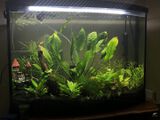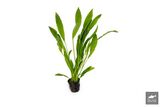Echinodorus grisebachii Parviflorus

| light: | much-medium |
|---|---|
| temperature: | 22-28°C |
| Growth: | medium |
| Location: | medium / background |
| Height: | 35 to 40 cm |
| pH: | 5-8 |
| Water hardness: | soft to hard |
| Co2: | 20-30 mg/L |
| propagation: | daughter plants on
flowering shoot |
Trade name of : Echinodorus grisebachii Small
German names : Schwarze Amazonas Schwertpflanze , Kleinblütige Amazonas Schwertpflanze
Small-flowered Echinodorus, Trade name Echinodorus peruensis, scientific name Echinodorus grisebachii Parviflorus is common in Peru and Bolivia. It is a medium-sized marsh plant. The plant is commonly known among aquarists as black amazon. This name is due to the color its leaves take under favorable conditions. Other closely related species that are popular in aquaristics are Echinodorus amazonicus and Echinodorus bleheri. They look similar, have elongated, lanceolate, green leaves on a short petiole grouped in a rosette, the leaf blade is dark green with dark brown veins forming a dense network, the petiole is up to 15 cm long. The leaves resemble those of Echinodorus Amazonicus, but are slightly wider. The plant forms a dense rosette that grows up to 35 - 40 cm high. Small-flowered Echinodorus can be kept in moderately warm tropical aquariums. The optimum temperature is 20 - 28 ° C. The water can be very soft to hard. The water should be changed regularly. In old, acidic water, this Echinodorus slows its growth and begins to shed old leaves. The plant is placed closer to the back wall of the aquarium. It is not very demanding in terms of lighting, but in the absence of light the leaves of the plant lose their interesting color and usually turn green. Natural light is very beneficial for this Echinodorus. For artificial lighting, all fluorescent lamps are suitable. With a daylight period of 14 hours or more, the plant can form elliptical leaves on long stems. The soil for the plant should be well silted and rich in nutrients. It is advisable to add additional fertilizer to the new soil under the roots in the form of clay or a mixture of clay and peat. The nature of the substrate has practically no effect on the growth of Echinodorus. Its strong root system requires a fairly thick layer of soil. In the aquarium it reproduces vegetatively. On its flower shoots form many daughter plants, which after the appearance of 4-5 leaves and a root system can be detached and transplanted to a new place. Propagation is possible throughout the year under favorable conditions.

![Echinodorus grisebachii Small[1]](/images/thumb/2/25/Grisebachii1.jpg/160px-Grisebachii1.jpg)
![Echinodorus grisebachii Small [1]](/images/thumb/7/79/Grisebachii2.jpg/120px-Grisebachii2.jpg)
![Echinodorus grisebachii Small [1]](/images/thumb/9/98/Grisebachii3.jpg/120px-Grisebachii3.jpg)
![Parviflorus Grisebachii [1]](/images/thumb/f/f9/Parviflorus_Grisebachii_1.jpg/160px-Parviflorus_Grisebachii_1.jpg)
![Parviflorus Grisebachii [1]](/images/thumb/3/31/Parviflorus_Grisebachii_2.jpg/160px-Parviflorus_Grisebachii_2.jpg)
![Parviflorus Grisebachii [1]](/images/thumb/2/2d/Parviflorus_Grisebachii_3.jpg/150px-Parviflorus_Grisebachii_3.jpg)


